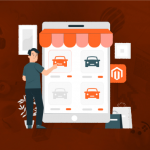How To Build A Car Dealership Website In Magento?
Last Updated | December 10, 2023
Table of Contents
Why would someone go to a website that sells cars? Right, to locate a suitable vehicle?
A car market needs a large selection of automobiles and a reliable sorting system.
A new digital world has emerged thanks to the Internet and smartphones. Online shopping is now available for everything from jingle bells to enormous SUVs. Companies with a digital presence generate enormous profits. In fact, the Covid-19 pandemic provided digital connectivity with an unstoppable push. Never before has the growth of online cars been as high.
According to Google data, an astounding 72 per cent of respondents looked up dealers online. 10% of them filled out a lead form, and the remaining 62% called the number provided on the website for the vehicle dealer. According to the survey, 59 per cent of them opted to buy a new or used automobile within the month, and 21 per cent of them actually paid for it using the website’s payment gateway.
It is now possible to purchase new or used automobiles online thanks to car-dealing websites, and demand for these websites is growing at the speed of light. The best option for a dealership will be to build a car dealership website for auto sales at the height of digital connectivity on Magento.
Industrial Future-Proof Stats
Due to the Covid-19 pandemic, the demand for digital connectivity and the internet has increased significantly, even in non-metro cities such as Tier-3 cities. From ordering foods, groceries, clothes, and shoes, to fast-moving consumer goods, Tier 1 and 2 cities are known to buy everything through online searches.
How does a car dealing website work?
A car dealership website is essential for everyone who owns or manages a vehicle dealership. The success of an agency can be determined by the type of website it has. People today seek the convenience of a home-based car buying and selling experience.
Customers are directed to car-dealing websites by their interest in YouTube videos that review designs, features, and driving tests. A car dealership websites include different functions and functionality which help the consumer to find the best vehicle with ease.
With a single tab and tones of automotive photographs and videos, a consumer may compare various cars, features, or even designs without having to write anything down. With the Wishlist feature, a user may now keep track of their favorite items and receive notifications when the price, an offer, or new listings are available.
In addition, the buyer may now reserve a car immediately via their mobile phones, enquire about a vehicle, or provide feedback without leaving their home, which is particularly useful while social distance is still in effect.
This feature enables a user to fully capitalize on the developing trend. The internet allows people to do things like book cars without having to trek for kilometers to get there. Mobile phones can visit websites for auto showrooms even at home.
The Car Dealership Websites’ Functions and Functionalities
A car dealing website is necessary for a car dealership, but it isn’t enough. You would need a car dealing website which is well to sell cars. A website for a vehicle dealer should have characteristics like efficient management, information on sales, products, and inventory, as well as the ability to keep customers informed about price changes, minor improvements, and new listings.
A car-dealing website’s features should be integrated in a way that gives end users a user-friendly and simple-to-use environment.
How to Build A Car Dealership Website With Magento?
At first, Magento could appear a little scary, but we’ve simplified the installation procedure for you. We’ll go over the procedures you’ll need to create and publish a website using the platform’s open-source edition.
It’s best to register for a free Magento account before you start. You may quickly switch between this portal and the website you’ll be creating, despite the fact that they are different. You may see details about the things you’ve bought, billing, and more on your user page.
Step # 1 – What are Magento’s Server Requirements For Building A Website
Magento, like the majority of website development platforms, has specifications that any server hosting the platform must meet. To make sure your website will function effectively, you should make a note of them before looking for a hosting company.
You must have the following in order to use Magento:
- Operating System
Linux x86-64 and more Linux versions like RedHat or Ubuntu. Using virtualization software or MAMP programs, you could also create natively on a Mac or Windows computer.
- Web Host
Your web server choice is between Apache and Nginx. It is advised that you consult the Magento Apache manual for integrative approach settings if you decide to use Apache.
-
Memory
After all, is said and done, the Magento installation will probably need at least 2GB of RAM.
-
Database
Versions 5.6 and 5.7 of MySQL are compatible with Magento.
-
Php
PHP 7.3 is what Magento advises using. Additionally, their PHP installation guide contains detailed steps that will help you make sure the required extensions are installed. This tutorial will also highlight additional settings, such as enabling OPcache, that will make your Magento installation perform more efficiently.
-
Security
For safe data transfers and PayPal integration, Secure Sockets Layer (SSL) certificates are advised.
Step # 2 – Selecting A Web Host And Domain Name
The next step is to go find a web host while carrying your list of system requirements. The majority will provide you with the hardware and tools required to operate Magento.
Nevertheless, it’s a good idea to be safe and select a supplier that provides help, particularly for the platform you’ll be utilizing.
Popular hosts with one-click Magento installation options include:
- Bluehost
- Hostinger
- DreamHost
It’s a good idea to take into account aspects like performance, security, and whether you can add any more features to your account in addition to comparing the rates for each of these organizations’ plans.
Making sure the plan you’ve chosen includes an SSL certificate is a crucial part of finding the ideal host for your Magento store.
Step # 3 – Downloading and Installation Of Magento To Build A Car Dealership Website
Go to the product page and select the Get Started option to install Magento Open Source.
The open-source platform and Magento Commerce feature comparison chart can be viewed after that. Click Download Open Source at the bottom of the chart.
Your destination will be the Magento Tech Resources website. You can get Magento Open Source in a number of ways from this page. Although you have the option to use a different format, the creators advise using Composer.
Choosing to install the platform with or without a data sample is another option. We’ll pick the most recently available release with sample data for this Magento tutorial.
If your server provides one, beginners can still use it to install Magento Open Source with just one click and get it going. Go to cPanel > Autoinstallers to accomplish this.
Step # 4 – Configuration Of The Admin Settings
The location of your Magento installation on your server and the URL route you want to use to access the admin login page must both be specified next. Click Install after you’re done modifying these options. You’ll get a confirmation message after the procedure is finished.
The Administrative URL can now be clicked, and you can sign in using the username and password you made while the installation is in process. You will then be sent to the new Magento dashboard, where you can start creating your brand-new online store.
Step # 5 – Choose and Install a Theme The Car Dealership Website
Choosing a design for the store is perhaps one of the initial things you want to accomplish. Your site’s appearance will be determined by this. You can frequently change the one you select to fit your logo.
You must first obtain your access keys before you can download and install themes from the Magento Marketplace. These can be located in your user account by going to Marketplace > My Products > Access Keys.
You’ll be required to create new keys and give them all names on the Access Keys page. You must copy both your public and private keys after completing this step. Go back to the dashboard for your Magento store and select Settings > Web Setup Wizard > Extension Manager.
To install an extension, you must return to your admin panel and select Extension Manager > Review and Install under Settings > Web Setup Wizard. Any extensions or themes that are available for installation will be listed when you do this.
Step # 6 – Tailored Theme
You may access your new theme by navigating to Content > Configuration after it has been installed. After choosing the webpage configuration you want to change, you may start altering its parameters. The interface for updating or adding a logo and other components for your online store can be found here:
Additionally, you can update your car dealership website’s pages, widgets, and the blocks that make up the site’s structure by using the Content > Elements menu.
Step # 7 – Exploring Extensions To Add More Functionalities
Additionally, you can purchase extensions for your store on the Magento Marketplace. This covers everything, from checkout settings to Instagram Widgets.
The decision over which extensions to utilize is ultimately up to you. Your eCommerce site’s objectives will determine everything. You could focus on the following broad categories;
- Security
- Marketing
- Analytics tracking
- Payment gateways
- Shipping
Step # 8 – Modify Your Store Settings
To do this, navigate to Stores > Settings > Configuration.
There are many options to take into account here, however some highlights you should hit include;
- Setting your location, time zone, and currency
- The email account to which transaction alerts should be sent
- If [global] or [online] should be the price scope
- Account settings for customers
- Options for shipping and payment
Step # 9 – Setting Up The Product Pages With Prices and Images
There are only a few steps involved in setting up products for your auto dealership website. You may see a list of your current products and the Add Product option by going to Catalog > Products:
If you click on it, a drop-down menu will appear where you may choose the kind of product you wish to add:
-
Simple Products
A typical physical good.
-
Adaptable Products
Simple goods with a variety of configurations.
-
Groupings Of Products
A selection of straightforward items that can be bought separately or all at once.
- Digital Products
Services, online classes, or other “things” that don’t need to be downloaded or shipped.
-
Combine products
A Grouping Of Things That Cannot Be Bought Separately.
-
Downloadable Products
Electronic books are examples of digital goods that may be downloaded.
The template you pick to construct the related page will depend on the product type you choose. A name, price, and Stockkeeping Unit (SKU) number must always be included. Weight, size, stock amount, and a description are all optional details.
The next option is to post a picture or a video of your product. This is smart because the majority of consumers want to see an item in person before they buy it.
Step # 10 – Selecting The Payment and Shipping Methods
You have several possibilities with Magento for both of these components to build a car dealership website.
You may access these settings by heading to Stores > Settings > Configurations, as we briefly described in Step 8. The left sidebar’s collapsible menu will then display a list of Sales followed by Payments Methods.
Step # 11 – The Preview and The Launch
Utilizing a setup or developing locally before pushing your modifications to your server is always recommended.
Pushing all of the Magento data to the web server is the final step if you’ve been constructing your website locally. You can accomplish this using a File Transfer Protocol (FTP) server or your local development program. Your website will then be published online for users to access and enjoy.
In the end, everybody wishing to launch an online store will find something useful in Magento. Magento is the best option for building a car dealership website, despite having a learning curve that may be higher than that of other well-known eCommerce platforms or plugins.
The Final Thoughts
One of the many eCommerce platforms that are gaining popularity is Magento. Even one-click installation alternatives are available from many websites hosting companies to set it up online. However, it can take some time to build a car dealership website online and get it functioning the way you want.
This guide should have provided you with enough knowledge to expedite the procedure. Even yet, you can discover that you need more details in order to advance the situation. Fortunately, there are a few helpful tools online, such as;
- The Magento Resources Library
- Magento Community Forums
The Magento developer community is very helpful, just like other significant open-source development projects.
| Task | Description |
|---|---|
| Prepare High-Quality Images | Collect crisp, high-resolution images of each car in your inventory. |
| Basic Image Editing | Use tools like Photoshop to enhance brightness, contrast, and color balance. Crop and resize images for consistency. |
| Magento Configuration | – Log in to your Magento Admin Panel. <br/> – Navigate to the product listings section. <br/> – Upload edited, high-resolution images for each car. |
| Leverage Magento’s Tools | – Utilize image compression settings. <br/> – Set up automatic image resizing. <br/> – Enable lazy loading for faster page loads. |
| Implement Alt Text | Add descriptive alt text to each image for accessibility and SEO benefits. |
| Test and Optimize | Regularly test page load times and adjust compression and resizing settings as needed. |
| Monitor Analytics | Use Magento or Google Analytics to track user engagement. Optimize images for popular listings. |
| Regular Updates | Keep inventory and images current. Remove outdated listings and refresh images for the latest arrivals. |
FAQs:
Q. Can a car dealership create a website using Magento’s platform?
A. Magento Development Services could initially seem a little intimidating, but we’ve made the installation process simpler for you. We’ll go over the steps required to build and publish a website using the open-source version of the platform.
Before you begin, it’s best to create a free Magento account. Despite the fact that they are distinct, you may easily switch between this portal and the website you will be building. On your user page, you may view information about the items you’ve purchased, billing, and more.
Q. Do Magento 2 developers help build a Car dealership website on Magento?
A. Yes, definitely they do. You can contact Team Folio3 for all kinds of Magento 2 integrations or migrations from any other eCommerce platform even building an entire website from scratch. You can hire Magento 2 developers with the best pricing plans in the entire marketplace with Folio3. Our experts and professionals will get you started within 32 hours.












